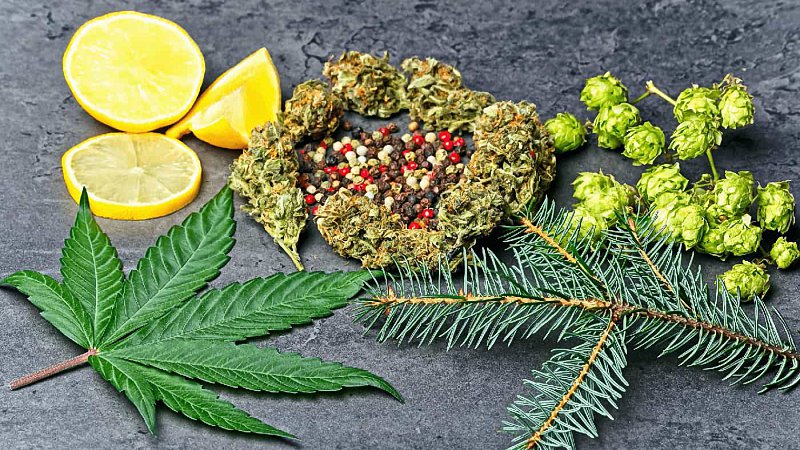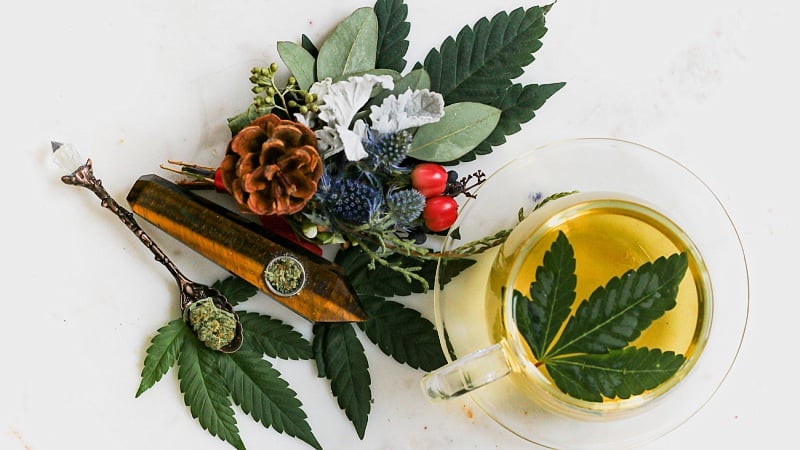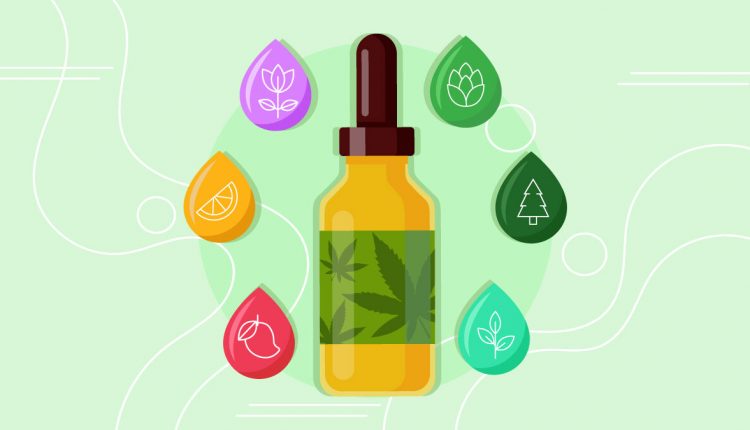Do terpenes matter when choosing CBD oil?
More importantly, should you buy CBD oil with terpenes?
The answer to both questions is yes.
Terpenes are important. When added to CBD oil, terpenes improve the taste and enhance the overall effectiveness of the oil.
To help you understand terpenes better, this article discusses what terpenes are, their benefits and effects, and their importance in CBD oils.
What are Terpenes?
All types of plants produce terpenes, and according to experts, there are over 20,000 different types of terpenes found in nature.
Trees, shrubberies, grass, flowers, fruits, vegetables, herbs, and even common weeds all have terpenes. They only differ in the types of terpenes they produce and their concentrations within the plant.
Terpenes are the reason why plants have different colors (pigment), aromas, flavors, and even effects.
They also serve as the plant’s protective system. The aroma and flavor they give off protect the plant against its natural predators like insects and animals. They also help strengthen the plant cells, protecting them against air pollutants and the sun’s UV rays.
These compounds also play an important role in plant reproduction. Their bright colors and sweet aroma, for example, attract pollinators like bees and butterflies. They carry the pollen from one plant to another, which of course, is vital for reproduction.
Terpenes also serve as the plant’s immune system, helping it fight off disease and illnesses. They have antibacterial, antifungal, antiviral, and other medicinal properties that maintain the plant’s health.
These properties are also why we benefit greatly from consuming vegetables and fruits.
Does CBD Oil Contain Terpenes?
Do all CBD oils contain terpenes?
Well, it depends on the type of CBD oil.
If you have pure CBD oil (called CBD isolate), it’ll only have CBD. It won’t have any additional compounds like other cannabinoids and terpenes.
On the other hand, using broad-spectrum or full-spectrum CBD oil means you’ll also be getting additional cannabinoids and terpenes. These phytochemicals all work together to produce positive effects on your health.
The only difference between the two is that full-spectrum CBD oil also contains traces of THC — typically 0.3% or less.
What are the Popular Terpenes Found in CBD Oil?

Cannabis produces over a hundred different types of terpenes, but only a few have been well-studied of these numbers.
Below are some of the best-researched terpenes found in cannabis plants.
1. Limonene
Also found in citrus fruits like orange and lemon, limonene has a refreshing citrusy and spicy aroma that energizes the mind and body.
This terpene helps relieve stress by boosting mood. Limonene also reduces swelling and pain. It also has antibacterial and antifungal effects that control infection.
2. Linalool
An aromatic terpene also found in lavender and rose, linalool produces a rich floral scent with hints of citrus fruits and spices.
Linalool also helps with discomfort. It eases tension, stress, sleeplessness, and forgetfulness. This terpene also fights bacteria and fungi.
3. Caryophyllene
Caryophyllene, also found in hops and cloves, gives off a spicy and woody aroma.
This terpene eases pain and inflammation. Its antibacterial and antifungal properties help fight off infection. Called “Beta-Caryophyllene,” this caryophyllene helps fight diabetes and its complications. There are
4. Pinene
A refreshing and invigorating terpene, pinene is commonly found in pine needles.
Pinene refreshes the mind, enhances memory, and helps clear brain fog. It also helps control pain and inflammation as well as reduce seizures.
There are two structural isomers of pinene found in nature called the Alpha Pinene and the Beta Pinene.
5. Myrcene
Myrcene has an interesting aroma. It gives off an earthy and musky aroma with robust fruity and herbal notes. This terpene is also found in mango, lemongrass, basil, and hops.
This Myrcene terpene has many therapeutic effects. It not only reduces pain and inflammation but also improves mood and sleep and fights bacteria. Myrcene also relaxes the muscles.
6. Humulene
Also found in black pepper, ginseng, sage, and hops, humulene offers a spicy, earthy, and woody aroma.
Humulene is called the jack of all trades of terpene and relieves discomfort and inflammation. It also has properties that help control weight.
7. Terpinolene
A terpene with floral, herbal, and piney aroma, terpinolene can also be found in apples, ginseng, nutmeg, and flowering plants like lilacs.
Terpinolene fights off infection caused by bacteria and fungus. It also helps improve sleep.
8. Ocimene
Ocimene also found in basil, lavender, and tarragon has an energizing and refreshing aroma. It smells sweet and woody with herbal and floral notes.
This terpene has antibacterial, antiviral, and antifungal effects. Ocimene also has anti-inflammatory as well as antioxidant properties.
9. Bisabolol
Also produced by chamomile and sage, bisabolol has a sweet, floral scent.
Bisabolol helps control pain and inflammation as well as fight infection caused by bacteria.
10. Eucalyptol
Minty and refreshing, eucalyptol is also produced by tea trees, rosemary, sagebrush, and peppermint.
Eucalyptol helps with pain and infections caused by fungi and bacteria. It also refreshes the mind and helps enhance memory. Its antioxidant properties also protect many organs from diseases.
Some terpenes like limonene, linalool, pinene, myrcene, terpinolene, and humulene also have anti-cancer effects.
What are the Benefits and Effects of Terpenes in CBD Oil?
Terpenes make up part of the entourage effect associated with cannabis.
The entourage effect is a phenomenon that states that all the compounds in cannabis work together in producing stronger beneficial effects compared to isolates.
Of the different CBD forms, this effect is strongest in full-spectrum CBD oil. Its cannabinoids (including THC) and terpenes amplify each other’s health effects.
Their presence makes the CBD oil more potent and more effective in maintaining mind and body health.
Terpenes also add more aroma and flavor to the CBD oil, although their scent and flavor are not as perceptible in CBD oils compared to smoking CBD flowers.
How to Use CBD Terpenes?

How to use CBD products containing terpenes depends on the CBD form, of course.
CBD oils and tinctures are oftentimes used as a sublingual product and placed under the tongue. They may also be added to foods and drinks and ingested like CBD edibles (candies, gummies, brownies, capsules, etc.)
Topicals like balms and ointments produce localized effects and are applied to the skin. CBD cream products like this work best for skin problems as well as joint and muscle aches and pains.
Inhalable CBD products like flowers and vapes are smoked and vaped.
Why Add Terpenes into CBD Oil?
When you smoke CBD-rich flowers, you’re also taking in all its naturally occurring cannabinoids and terpenes.
This isn’t the case with CBD oils.
We lose some of the plant material’s cannabinoids and terpenes during the extraction process, affecting the product’s potency and quality.
Some producers add terpenes back into the product to enhance CBD’s effects to increase its potency and efficacy.
However, the more processed the oil, the less it captures the plant’s essence, and the farther its quality gets from the original source.
When choosing CBD oils with terpenes, the extraction process should matter a lot.
How to Choose CBD Oils & Vapes with Terpenes
Not all CBD oils and vapes are created equal, so you have to be discerning in choosing your CBD product as a consumer.
Below are some tips to choose the best CBD oils and CBD vapes with terpenes.
1. Know the Extraction Process
There are many ways to extract CBD. The most common ones include oil, alcohol, and supercritical carbon dioxide extraction methods.
The supercritical CO2 extraction method produces the cleanest, safest, and most potent end product of these different methods.
It doesn’t use too high temperatures that can damage or destroy the cannabinoids and terpenes. This preserves their quality and potency.
Because it’s solvent-free, the end product doesn’t contain residual solvents. Toxic residues and byproducts are commonly seen in the alcohol extraction method.
Moreover, this method also kills off any pathogenic microorganisms (bacteria, fungi, etc.), resulting in a safe, contaminant-free product.
2. Look for Certificate of Analysis or COA
It would help if you also looked for the CBD product’s certificate of analysis done by a reputable laboratory testing facility. This proves that the product underwent necessary testing to check for its safety, quality, and potency.
The COA should show the product is contaminant-free and contains the stated cannabinoid and terpene profile and potency.
3. Read Product Reviews
Reading product reviews and customer feedback is just as important.
Don’t buy CBD products that receive more negative than positive reviews. If most of those who tried the product didn’t enjoy it, you probably won’t either.
Product reviews give you an idea of just how good and effective (or not!) the CBD with terpenes is.
4. Choose Full-Spectrum CBD
If you’re after a more potent effect, choose full-spectrum CBD oils and vapes. The presence of more cannabinoids (including THC) and terpenes helps add to the product’s overall potency and effectiveness.
Again, look for the product’s COA. Make sure that it shows not only the cannabinoid profile but also its terpene profile. Check their concentration as well.
Final Thoughts — Terpenes in CBD Oil Matter
Terpenes, on their own, have many therapeutic effects.
They help relieve pain and swelling, boost mood, fight infection, improve sleep, and relax muscles. Some terpenes enhance memory, and some may even reduce the proliferation of cancer cells.
Does their presence in CBD oil matter?
It definitely does!
Terpenes add to the overall aroma and flavor of CBD oil. More importantly, they enhance CBD’s beneficial effects.
Do you pay attention to terpenes in your CBD oil? What blends of aromas work best for you? Let us know in the comments below!
References Used In This Article
- d’Alessio, P. A., Bisson, J. F., & Béné, M. C. (2014). Anti-stress effects of d-limonene and its metabolite perillyl alcohol. Rejuvenation Research, 17(2), 145–149. [1]
- Hashiesh, H. M., Meeran, M., Sharma, C., Sadek, B., Kaabi, J. A., & Ojha, S. K. (2020). Therapeutic Potential of β-Caryophyllene: A Dietary Cannabinoid in Diabetes and Associated Complications. Nutrients, 12(10), 2963. [2]
- Salehi, B., Upadhyay, S., Erdogan Orhan, I., Kumar Jugran, A., L D Jayaweera, S., A Dias, D., Sharopov, F., Taheri, Y., Martins, N., Baghalpour, N., Cho, W. C., & Sharifi-Rad, J. (2019). Therapeutic Potential of α- and β-Pinene: A Miracle Gift of Nature. Biomolecules, 9(11), 738. [3]
- Valente, J., Zuzarte, M., Gonçalves, M. J., Lopes, M. C., Cavaleiro, C., Salgueiro, L., & Cruz, M. T. (2013). Antifungal, antioxidant, and anti-inflammatory activities of Oenanthe crocata L. essential oil. Food and chemical toxicology: an international journal published for the British Industrial Biological Research Association, 62, 349–354. [4]
- Seol, G. H., & Kim, K. Y. (2016). Eucalyptol and Its Role in Chronic Diseases. Advances in experimental medicine and biology, 929, 389–398. [5]
